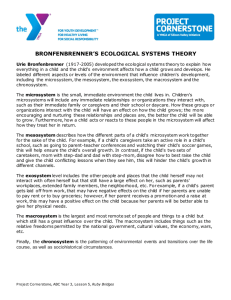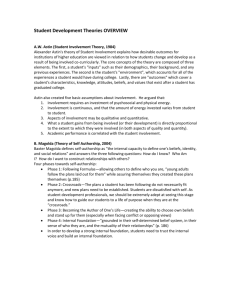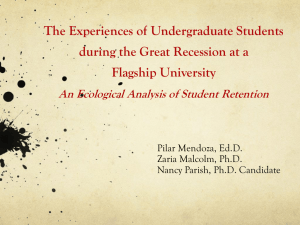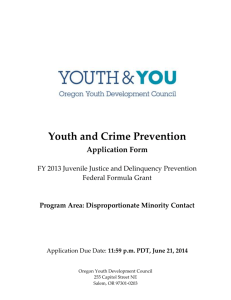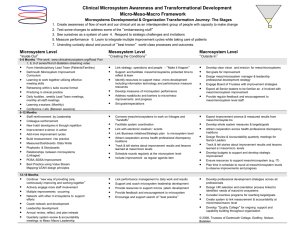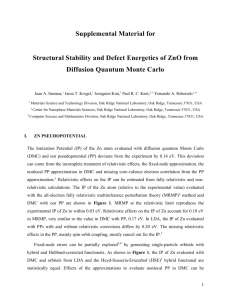Washington State Disproportionate Minority Contact Assessment
advertisement
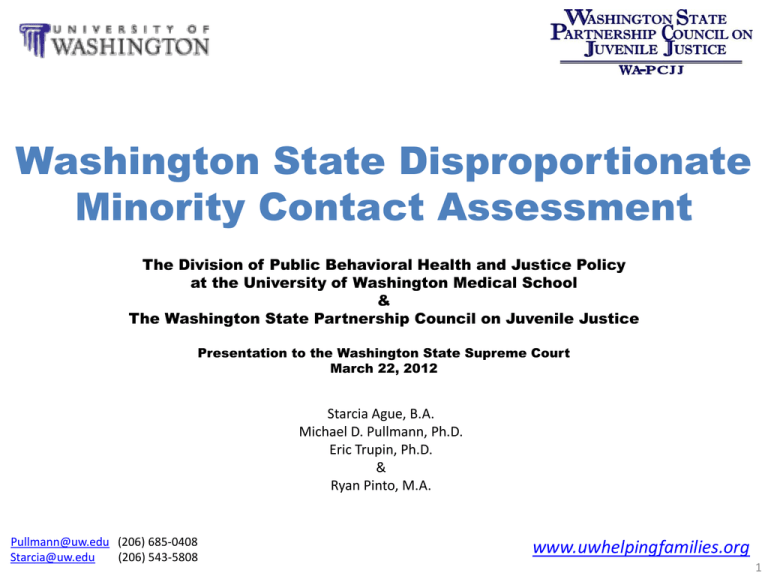
Washington State Disproportionate Minority Contact Assessment The Division of Public Behavioral Health and Justice Policy at the University of Washington Medical School & The Washington State Partnership Council on Juvenile Justice Presentation to the Washington State Supreme Court March 22, 2012 Starcia Ague, B.A. Michael D. Pullmann, Ph.D. Eric Trupin, Ph.D. & Ryan Pinto, M.A. Pullmann@uw.edu (206) 685-0408 Starcia@uw.edu (206) 543-5808 www.uwhelpingfamilies.org 1 Differential offending behavior Differential treatment Disproportionate Minority Contact Risk factors (legal factors such as prior offense) Risk factors (psychosocial) 2 Chronosystem Macrosystem Exosystem Mesosystem Factors at the level of the youth Differential offending behavior Earlier contact with law enforcement Youth educational problems Gang membership Impulsivity Microsystem Youth 3 Chronosystem Macrosystem Exosystem Mesosystem Microsystem Youth Microsystem (the immediate environment) Family poverty Neighborhood poverty Single-parent households Age of mother at first birth Low parental education Parental physically harsh punishment Unequal access to services and activities Services and activities may not be culturally appropriate Peer behavior Poor functioning schools “Attractive Nuisance” 4 Chronosystem Macrosystem Exosystem Mesosystem Microsystem Youth Mesosystem (interactions among immediate environment) Institutional effects (regional facilities) “Loose coupling” within the juvenile justice system Policies and procedures Targeted enforcement “School-to-prison pipeline” Institutional racism Appropriate and inappropriate decision-making criteria 5 Chronosystem Macrosystem Exosystem Mesosystem Exosystem (economic, political, religious systems) Legislation, policies, and legal factors Acquisition and retention of political power Microsystem Youth 6 Chronosystem Macrosystem Exosystem Macrosystem (overarching beliefs and values) Conscious or unconscious racial bias Cultural values Mesosystem Microsystem Youth 7 Chronosystem Macrosystem Exosystem Mesosystem Chronosystem (time) Historical trauma Slavery Immigration, seasonal mobility, migration Microsystem Youth 8 Washington State DMC Assessment • Underway by University of Washington’s Division of Public Behavioral Health and Justice Policy – Contracted by the Washington State Partnership Council on Juvenile Justice • 12 jurisdictions—most populous & those engaged in JDAI • Multi-method and iterative: Statistical assessment, and qualitative depth interviews with 4-7 stakeholders in each jurisdiction 9 Adams 1 1 1 1 Benton/Franklin 1 1 1 1 1 Clark 1 King 1 1 1 2 Mason 1 1 Pierce 1 1 Other JDAI Coordinator Data analyst Community member Police Court administration County Judge or Commissioner Completed/Scheduled Interviews 2 1 2 1 Kitsap 1 1 1 Skagit 1 1 Spokane 1 1 1 Thurston 1 1 1 Whatcom 1 1 2 1 10 Preliminary findings: Data collection and analysis needs improvement • Most law enforcement agencies collect data defined by the Uniform Crime Reports, excluding Hispanic ethnicity – Most Hispanics categorized as white at arrest • Data on youth in probation are not consistently available nor centralized • Current categorizations may obscure the needs of certain groups of concern: East African immigrants, indigenous Mexicans, Eastern European immigrants, Southeast Asians • Some jurisdictions seem unclear about the definitions for decision points and/or racial and ethnic categories • Most jurisdictions need assistance in how to use data to assess and address DMC 11 Preliminary findings • Highly localized & variable from jurisdiction to jurisdiction – Awareness of DMC – “Ownership” of DMC – Explanations for DMC – Approaches to addressing DMC • Deep concern within most court administrations that disproportionality has remained steady while overall court contacts have dropped • “Loose coupling” of the juvenile justice system is cited as barrier to addressing DMC 12 Most common stakeholder explanations for DMC • Risk factors correlated with offending: Poverty, adverse childhood experiences, single parenting, adult supervision, gang presence • Targeted enforcement • Lack of trust or understanding among courts, police, and communities of color • Unequal social power—fewer minority political, business, and service system leaders • Conscious or unconscious bias 13 Approaches to addressing DMC • Many jurisdictions have not made attempts to formally address DMC • Those that try to address it use one or more of the following approaches – 1. Community engagement – 2. Changes to policy and practice – 3. Prevention and intervention programs • Most important: Base DMC reduction approaches on local data, local experiences, and local stakeholder involvement 14 Next steps • Continue to interview stakeholders • For interested jurisdictions, work on more detailed analyses • Collaborate with WA-PCJJ to provide support to local jurisdictions • Final report due in October, 2012 15 16

